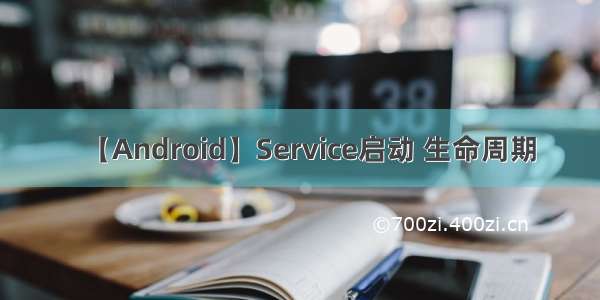
Android Service的生命周期
Managing the Lifecycle of a Service
service的生命周期,从它被创建开始,到它被销毁为止,可以有两条不同的路径:
A started service
被开启的service通过其他组件调用startService()被创建。
这种service可以无限地运行下去,必须调用stopSelf()方法或者其他组件调用stopService()方法来停止它。
当service被停止时,系统会销毁它。
A bound service
被绑定的service是当其他组件(一个客户)调用bindService()来创建的。
客户可以通过一个IBinder接口和service进行通信。
客户可以通过unbindService()方法来关闭这种连接。
一个service可以同时和多个客户绑定,当多个客户都解除绑定之后,系统会销毁service。
这两条路径并不是完全分开的。
即是说,你可以和一个已经调用了startService()而被开启的service进行绑定。
比如,一个后台音乐service可能因调用startService()方法而被开启了,稍后,可能用户想要控制播放器或者得到一些当前歌曲的信息,可以通过bindService()将一个activity和service绑定。这种情况下,stopService()或stopSelf()实际上并不能停止这个service,除非所有的客户都解除绑定。
Implementing the lifecycle callbacks
和activity一样,service也有一系列的生命周期回调函数,你可以实现它们来监测service状态的变化,并且在适当的时候执行适当的工作。
下面的service展示了每一个生命周期的方法:
public class ExampleService extends Service{int mStartMode; // indicates how to behave if the service is killedIBinder mBinder; // interface for clients that bindboolean mAllowRebind; // indicates whether onRebind should be used@Overridepublic void onCreate(){// The service is being created}@Overridepublic int onStartCommand(Intent intent, int flags, int startId){// The service is starting, due to a call to startService()return mStartMode;}@Overridepublic IBinder onBind(Intent intent){// A client is binding to the service with bindService()return mBinder;}@Overridepublic boolean onUnbind(Intent intent){// All clients have unbound with unbindService()return mAllowRebind;}@Overridepublic void onRebind(Intent intent){// A client is binding to the service with bindService(),// after onUnbind() has already been called}@Overridepublic void onDestroy(){// The service is no longer used and is being destroyed}}
不像是activity的生命周期回调函数,你不需要调用基类的实现。
这个图说明了service典型的回调方法,尽管这个图中将开启的service和绑定的service分开,但是你需要记住,任何service都潜在地允许绑定。
所以,一个被开启的service仍然可能被绑定。
实现这些方法,你可以看到两层嵌套的service的生命周期:
The entire lifetime
service整体的生命时间是从onCreate()被调用开始,到onDestroy()方法返回为止。
和activity一样,service在onCreate()中进行它的初始化工作,在onDestroy()中释放残留的资源。
比如,一个音乐播放service可以在onCreate()中创建播放音乐的线程,在onDestory()中停止这个线程。
onCreate()和onDestroy()会被所有的service调用,不论service是通过startService()还是bindService()建立。
The active lifetime
service积极活动的生命时间(active lifetime)是从onStartCommand()或onBind()被调用开始,它们各自处理由startService()或bindService()方法传过来的Intent对象。
如果service是被开启的,那么它的活动生命周期和整个生命周期一同结束。
如果service是被绑定的,它们它的活动生命周期是在onUnbind()方法返回后结束。
注意:尽管一个被开启的service是通过调用stopSelf()或stopService()来停止的,没有一个对应的回调函数与之对应,即没有onStop()回调方法。所以,当调用了停止的方法,除非这个service和客户组件绑定,否则系统将会直接销毁它,onDestory()方法会被调用,并且是这个时候唯一会被调用的回调方法。
Managing the Lifecycle of a Bound Service
当绑定service和所有客户端解除绑定之后,Android系统将会销毁它,(除非它同时被onStartCommand()方法开启)。
因此,如果你的service是一个纯粹的绑定service,那么你不需要管理它的生命周期。
然而,如果你选择实现onStartCommand()回调方法,那么你必须显式地停止service,因为service此时被看做是开启的。
这种情况下,service会一直运行到它自己调用stopSelf()或另一个组件调用stopService(),不论它是否和客户端绑定。
另外,如果你的service被开启并且接受绑定,那么当系统调用你的onUnbind()方法时,如果你想要在下次客户端绑定的时候接受一个onRebind()的调用(而不是调用onBind()),你可以选择在onUnbind()中返回true。
onRebind()的返回值为void,但是客户端仍然在它的onServiceConnected()回调方法中得到IBinder对象。
下图展示了这种service(被开启,还允许绑定)的生命周期:
参考资料
API Guides:Services
/guide/components/services.html
API Guides:Bound Services
/guide/components/bound-services.html
















